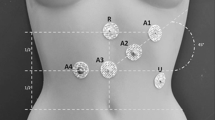Abstract
Electrogastic measurements are useful for medical research and in clinical diagnosis. The measurements, however, contain very heavy respiratory artefact. Existing conventional frequency-domain filters cannot be used because of the possible overlap of the frequencies of the gastric signals and respiratory artefact. In the paper, the methods of measuring cutaneous and intraluminal gastric signals and reference respiratory signals are described. An adaptive cancellation technique is developed, which is simple and easy to implement for online processing. It is proved by experiments to be very efficient, i.e. the respiratory artefact can be completely cancelled, while the gastric signal component is not affected. Other possible applications in biomedical signal analysis are also discussed.
Similar content being viewed by others
References
Alyarez, W. C. (1922) The electrogastrogram and what is shows.J. Am. Med. Assoc.,78, 1116–1118.
Brown, B. H., Smallwood, R. H., Duthie, H. L. andStoddard, C. J. (1975) Intestinal smooth muscle electrical potentials recorded from surface electrodes.Med. & Biol. Eng.,13, 97–103.
Chen, J., Vandewalle, J., Sansen, W., Vantrappen, G. andJanssens, J. (1978a) Adaptive enhancement of human electrogastrography. Proc. 9th Ann. Conf. of IEEE/Eng. in Med. & Biol. Soc., Boston, USA, Nov. 1987, 858–859.
Chen, J., Vanderwalle, J., Sansen, W., Vantrappen, G. andJanssens, J. (1987b) Adaptive cancellation of respiratory disturbance in electrogastric signals. Proc. Int. Conf. on Digital Signal Processing, Florence, Italy, Sept. 1987, 901–905.
Chen, J. andVandewalle, J. (1988) An μ-vector LMS adaptive system for enhancing nonstationary narrow band signals. Proc. IEEE Int. Symp. on Circuit and System, Findland, June 1988, 771–774.
Goodman, E. N., Colcher, H., Katz, G. M. andDangler, C. L. (1955) The clinical significance of the electrogastrogram.Gastroenterol. 29, 598–607.
Kentie, M. A., van der Schee, E. J., Grashuis, J. L. andSmout, A. J. P. M. (1981a) Adaptive filtering of canine electrogastrographic signals. Part 1: System design.Med. & Biol. Eng. & Comput.,19, 759–764.
Kentie, M. A., van der Schee, E. J., Grashuis, J. L. andSmout, A. J. P. M. (1981b) Adaptive filtering of canine electrogratrographic signals. Part 2: Filter performance.—Ibid.,,19, 765–769.
Linkens, D. A. andDatardina, S. P. (1978) Estimation of frequencies of gastrointestinal electrical rhythms using autoregressive modelling,—Ibid.,,16, 262–268.
Nelsen, T. S. andKohatsu, S. (1968) Clinical electrogastrography and its relationship to gastric surgery.Am. J. Surg.,116, 215–222.
Rabiner, L. R., Scharfer, R. W. andDlugos, D. (1979) Correlation method for power spectrum estimation. InPrograms for digital signal processing. IEEE Press.
Smallwood, R. H. (1978) Analysis of gastric electrical signals from surface electrodes using phaselock techniques.Med. & Biol. Eng. & Comput.,16, 507–518.
Stern, R. M. andKoch, K. L. (Eds.) (1985)Electrogastrography. Praeger, New York.
Stoddard, C. J., Smallwood, R. H. andDuthie, H. L. (1981) Electrical arrythmias in the human stomach.Gut.,22, 705–712.
van der Schee, E. T. andGrashuis, J. L. (1983) Contrationrelated, low-frequency components in canine electrogastrographic signals.Am. J. Physiol. 245, G470-G475.
Van der Schee, E. J. andGrashuis, J. T. (1987) Running spectrum analysis as an aid in the representation and interpretation of electrograstrographic signals.Med. & Biol. Eng. & Comput.,25, 57–62.
Widrow, B., Glover, J. R. Jr., McCool, J. M., Kaunitz, J., Williams, C. S., Hearn, R. H., Zeiler, J. R., Dong, E. J. Jr., andGoodlin, R. C. (1975) Adaptive noise cancellation: principles and applications.Proc. IEEE,63, 1692–1716.
Author information
Authors and Affiliations
Rights and permissions
About this article
Cite this article
Chen, J., Vandewalle, J., Sansen, W. et al. Adaptive method for cancellation of respiratory artefact in electrogastric measurements. Med. Biol. Eng. Comput. 27, 57–63 (1989). https://doi.org/10.1007/BF02442170
Received:
Accepted:
Issue Date:
DOI: https://doi.org/10.1007/BF02442170




